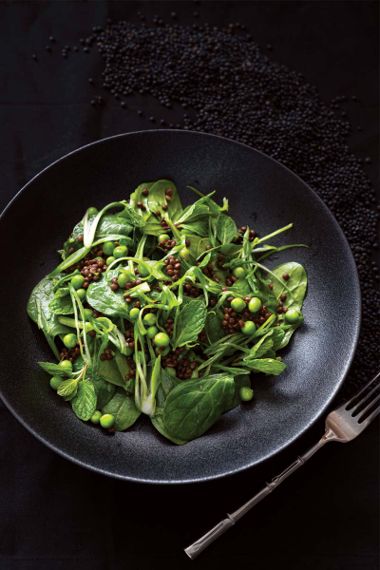
Small black beluga lentils, so called because of their resemblance to caviar, hold their shape well, making them perfect for salads. If you can’t find beluga lentils, use French Puy lentils, which have similar properties. With lentils, young spinach, spring peas, and herby dressing, this salad welcomes spring.
Sustainability cred
Symbiotic bacteria called Rhizobium invade the roots of lentils and legumes such as peas and beans, allowing them to “fix,” or use, nitrogen. This also improves the quality of the soil they grow in. When grown as part of a crop rotation system, they make the soil suitable to grow other plants, including grains, that require nitrogen.
Be picky
Packaged lentils may contain small stones or other debris which, for safety, should be removed. To pick over lentils, take small amounts of lentils and spread them on a flat surface such as a cutting board. Using a bench scraper or palette knife, or simply your hands, review the contents and move from one end of the board to the other, removing any debris you find on the way.
Fun fact: The word lentil is derived from the word for lens. You might want to get a pair to complete this task!
What to look for: When choosing lentils, look for organic lentils to avoid glyphosate residues that can be found in conventionally grown varieties.
Herby Lentil Salad with Spinach and Peas
Ingredients
- 1 cup (500 mL) black beluga or French Puy lentils
- 1 bay leaf
- 1/4 cup (60 mL) green peas
- 1/4 cup (60 mL) finely sliced cilantro
- 1/4 cup (60 mL) finely sliced parsley
- 1/4 cup (60 mL) finely sliced mint
- 1/4 cup (60 mL) red wine vinegar
- 1 Tbsp (15 mL) extra-virgin olive oil
- 1/4 tsp (1 mL) salt
- 3 green onions, finely sliced
- 1 cup (500 mL) baby spinach
Nutrition
Per serving:
- calories95
- protein5 g
- total fat4 g
- sat. fat1 g
- total carbohydrates11 g
- sugars1 g
- fibre4 g
- sodium162 mg
Directions
01
Pick over lentils, removing pebbles or debris, and rinse. Bring a large pot of water to boil and add lentils and bay leaf. Reduce to medium-low and cook lentils at a slow simmer for 20 minutes, or until tender but not mushy. Drain and rinse with cool water to stop the cooking process.
02
In separate pot, blanch green peas for 2 to 3 minutes; drain and rinse with cool water.
03
In small bowl, combine herbs, vinegar, olive oil, and salt.
04
In large bowl, place cooked and cooled lentils. Pour dressing overtop lentils; add green onions, blanched peas, and baby spinach; and toss together. Tip out onto large shallow platter to serve.





